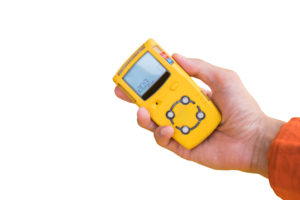
Gas monitoring and detection systems can save lives. They ensure workplace safety by alerting personnel to their exposure to toxic gas, the presence of combustible gases, and the lack of oxygen in a given area. There are two main types of gas leakage detection systems: portable gas detectors and fixed gas detectors. The following factors will determine which gas leak detection equipment is most appropriate for you:
- The source of the gases
- Whether the hazard is temporary or chronic
- Environment of the site
- Typical occupancy of the affected site
- Time required for workers to safely exit the affected area
- Training required to operate the detection system
- Expense
Fixed Gas Detectors
Fixed gas detectors are generally installed in large facilities and are used to both detect major leaks and as an early warning of gas leaking from a particular system. Fixed gas detection systems are configured using relays and customizable alarm point settings. These settings ensure that fixed gas detectors respond quickly to atmospheric hazards. Relays provide a number of functions that can be crucial to saving lives, including opening/closing ventilation and exhaust fans, triggering auditory and visual alarms, and closing electronic valves.
Pros:
- Fixed gas detectors provide you with automatic responses.
- They can set to shut down a system once a leak reaches a specified alarm level.
- They monitor flammable and toxic gas levels to keep your personnel safe.
- Fixed gas detectors can be used in tandem with area detectors to sense dangerous leaks alert the plant manager.
Cons:
- Fixed gas detectors are more expensive than portable detectors.
- They only detect gas that diffuses into it, meaning it cannot completely cover the leak potential in a given area.
- Due to their limited coverage ability, the likelihood of personnel and a leaking gas moving into the same uncovered area without warning from a fixed gas detector is extremely high.
- They’re impractical for areas that may be cramped or difficult to reach.
- Unlike portable detectors, fixed detectors require a main power supply.
Portable Gas Detectors
Portable gas detectors keep workers safe from atmospheric hazards by continuously monitoring the user’s breathing zone (which is typically within a 25cm radius of the user’s mouth.) Since these detectors must operate at close range to the user, they are often handheld, lightweight devices that can be easily worn or attached to a belt. For this reason, they are often referred to as personal gas detectors. Due to their size, they’re also often used to test confined spaces for safe entry.
Pros:
- You can take this gas detector pretty much anywhere.
- Portable gas detectors typically cost less than fixed gas detection systems.
- Portable gas detectors are the safest measure for workers under the threat of either continuous exposure or unstable atmospheric conditions.
- Most are battery powered eliminating the need for a main power source.
Cons:
- To ensure proper usage, operators must be carefully trained.
- Portable gas detectors don’t provide automatic responses, leaving the user to take action on their own in the event of a gas leak.






